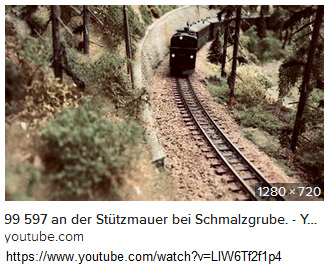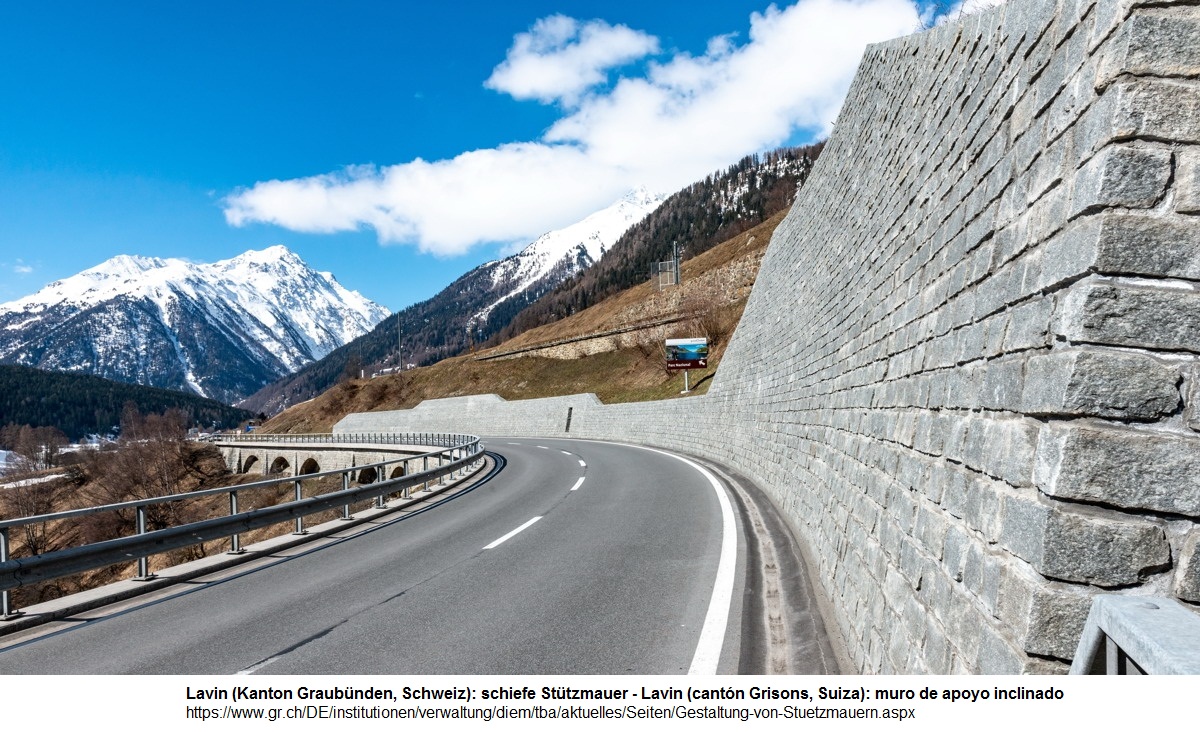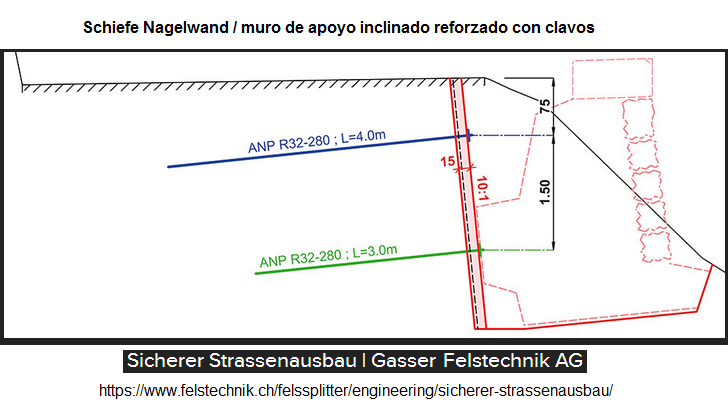E-mail to the Peruvian Traffic
Board in Lima:
October 21, 2021:
For 9 years, I have lived in Peru, and I was observing
again and again that the streets in the high Andes
have big difficulties with retaining walls which never
worked because the mountain became always "stronger"
than the wall, and until today [2021] landslides are
normal again and again. Tons of stones were joint in
rids, but it never worked. And I did not know where
the solution was.
Only today, October 21, 2021,
I see the
solution how in Switzerland the retention walls
are built. I send you 3 examples of
ICLINED retention walls, these are photos from a book
for traffic theory for learning driving cars: The
stones are put in rows in an INCLINED position.

Swiss Alps, inclined retention wall 01 [1]
As you can see, the stones and rocks are piled in an
INCLINED position for neutralizing the energy of the
mountain.
And here are more examples:

Swiss Alps, inclined retaining wall 02 [2]
Swiss Alps, inclined retaining
wall 03 [3]

Inclined concrete retaining wall
with nails, plan and procedure at Broc (canton of
Fribourg, Switzerland) from Gasser Rock Technique
[11]
The principle with a mountain slope is always the
same: a retaining wall has to be INCLINED for
neutralizing the energy of the mountain.
Every dike has such inclined "walls".
from:
https://es.wikipedia.org/wiki/Dique
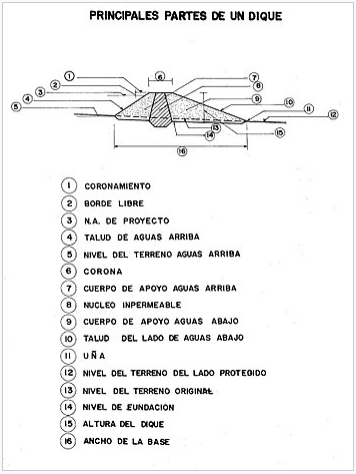
Dike with inclined walls, scheme [12]
And every retaining wall is like a dike for stopping a
mountain, and has to be inclined.
A concrete retaining wall for streets also has to be
built INCLINED:
Example from Uznach (Switzerland):
https://www.truempi-ag.ch/b/1051/77/sanierung-stuetzmauer-ernetschwilerstrasse-uznach

Uznach (Switzerland): inclined retaining wall in
concrete [13]
It's known that the waterside promenade of Trujillo
(Peru) was destroyed - why so?
Photos from 2010:
http://www.am-sur.com/am-sur/peru/Trujillo/Tru-Buenos-Aires-playa-y-malecon-destruido-y-proteccion-falta-ESP.html

Trujillo (Peru) in 2010: The waterside promenade was
destroyed because the elements were put in a right
angle [14]
Because this wall was not installed in an inclined
angle, but practically vertically in a right angle,
and therefore the sea destroyed the construction. With
an inclined manner of construction like with a dike
this had never happened. Of course, the Pacific Ocean
should not be robbed a complete beach for winning
houses and territories... So, the houses have to be
destroyed and the beach has to be reinstalled.
Now you know the trick with the inclined retaining
walls and I hope that you will not have any landslides
any more in the Andes. The same counts for all Latin
"American" countries like Ecuador, Colombia, Bolivia,
Chile, Venezuela, etc. This e-mail can be transmitted
to your colleagues of Construction Boards.
Unfortunately, the responsible people who are only
reading the Bible, they are BLIND of fantasies, and
this responsible people never see the reality and the
possibilities for a better life. But Mother Earth sees
it.
Addition 1: The construction of an
inclined dry wall about 1,2m high
from: Werner Natursteine in Amstetten (Germany):
https://www.werner-natursteine.com/nützliches/verarbeitungsanleitungen/kleine-stützmauer-trockenmauer/
Translation partly with Deepl:

Construction of an inclined dry wall - scheme. [15]
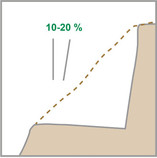
Construction of an inclined dry wall - step 1: The
slope has to be cut [16]
First, the hill or slope has to be cut. This cut
should have the future inclination, thus in a slightly
inclined way (10-20%). Advice: Keep about a quarter of
the soil to create the top of the slope later. You can
also use excavated stones as backfill later.
Step 2: Install an inclined basement

Building a sloping drywall Step 2: You install the
sloping foundation [17]
Up to a height of about 1.20 meters, a compacted
gravel bed (mineral concrete) is sufficient for this
purpose.
For the foundation, the soil is excavated to a depth
of about 30 cm and refilled with mineral concrete. It
is best to take crushed stone with a grain size of
0-32 or 0-45 and then compact it with a vibrator.
The width of the basement should be the width of the
base of the wall and a few centimeters allowance on
each side, so that the bottom row of stones can rest
evenly in a uniform way. The depth of the wall should
be about one-third of the height of the wall, which
makes a depth of 40 cm for a height of 1.20 meters.
Retaining walls are created with an inclination of
10-15% towards the slope. For reaching this desired
inclination, it's a help when also the basement has
got such an inclination towards the slope.
Step 3: You put the fleece, then the first row of
stones, the drainage - and behind it the first
gravel

Building an inclined dry stone wall - step 3: Place
the fleece, then the first row of stones, the drainage
and behind it the first gravel [18].
On the first row of stones comes the weight of the
whole wall. To distribute the weight over a large
area, these stones should have a large, uniform
surface on the top. (At the bottom they can be
irregular, because there they will be sunk into the
foundation if necessary). Well, all these stones
should be equally high.
And control that the
stones get a firm grip.
If you are using a drainage pipe or fleece
(recommended for higher walls or heavy soil), place it
behind the first row of stones and then embed it with
backfill, or attach the fleece to the slope as a
future boundary between earth material and gravel or
crushed stone backfill.
Then fill behind the first row with gravel or crushed
stone, including in the gaps between the backs of the
wall stones. Now you need to compact the fill material
around the stones to finally align and secure them.
(You can use the long, pointed side of a mason's
hammer to do this). Poke the tool into the fill around
the masonry units, compacting the voids as you go. If
material sinks in, refill with new material until all
holes are filled.



